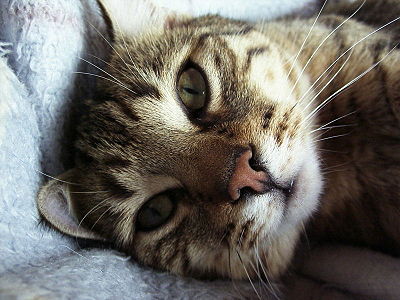
Cat Nasal Discharge
Veterinarian Reviewed on June 21, 2012 by Dr. Janice Huntingford
Cat Nasal Discharge
If a cat is exhibiting signs of nasal discharge, it can be extremely concerning for a pet owner. If persistent for several hours, this nasal discharge can be an indication of a serious problem. Recognizing these early stages of illness can help you prevent and circumvent further health complications down the road.
Types of Discharge
A discharge accompanied with sneezing and a consistency similar to water is generally caused by irritation or Cat Allergies. It can also be a sign of a viral infection. If the cat is experiencing a heavy mucous discharge, this is characteristic of a respiratory disease that is usually viral in nature. Respiratory diseases are highly contagious in felines and those who exhibit this should be separated from other cats within the home until a veterinarian can evaluate them. Alternately, if the cat is expelling a pus-like discharge, this is more than likely an infection caused by bacteria. Usually, the nasal discharge will begin as a fluid but can easily progress into a mucoid consistency followed by pus-like constituents. This can be indicative of the proliferation of many pathogens.
Causes
If the feline has discharge expelling from both nostrils, Cat Fever, refusal to eat or Cat Loss of Appetite, sores around and in the mouth as well as the cat experiencing Cat Coughs, this is a clear sign of a viral respiratory disease. If breathing is difficult through the nose due to swollen membrane tissue and the cat exhibits noisy habits and often uses its mouth to breathe, it is imperative to make an appointment with a veterinarian, as these are signs of respiratory obstructions.
If the cat has allergies, both nostrils are generally affected and the discharge appears to be slightly thick but generally clear. Other instances of tumors, fungal and bacterial infections can destroy healthy nasal tissue causing blood to appear in the mucous discharge. It can be from either nostril – single or the pair. Of course, if the cat has any blood in any discharge it must be taken to a doctor for examination. The usual fungal cause is from Cryptococcus.
Nasal discharge can often mean a nasal infection after proliferated bacteria attacks the lining of the nose following a trauma or pre-existing condition (such as viral respiratory disease). Many signs such as sneezing, noisy breathing, and breathing out of the mouth should be watched for, as they need immediate medical attention. In some instances, the infection may spread to the sinuses, which is indicative of an infected tooth root. They can also be a secondary condition in response to a Cat Cancer tumor within the actual cavity. Thus, it is extremely important that the cat be taken to the veterinarian for the appropriate tests and examination.
Treatment
If any cats in your care have nasal discharge, the most important thing to do is to make an appointment with a veterinarian. Be sure to outline all the symptoms and watch the cat closely in order to disclose all pertinent information. Encourage feeding of your cat by using aromatic enticement such as tuna or juice so they can keep up their strength during the illness. Only a veterinarian can prescribe your cat anti-fungal or antibiotics if need be. The most effective treatment is precaution, so be sure to take your feline to a doctor as soon as possible.
Sign up for our newsletter and receive more articles and the latest pet health updates and special offers.
Our Expert
 Dr. Janice Huntingford
Dr. Janice HuntingfordJanice Huntingford, DVM, has been in veterinary practice for over 30 years and has founded two veterinary clinics since receiving her Doctor of Veterinary Medicine at the Ontario Veterinary College, University of Guelph. She has studied extensively in both conventional and holistic modalities. Ask Dr. Jan

